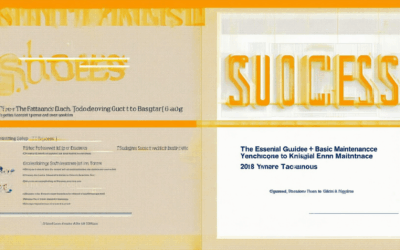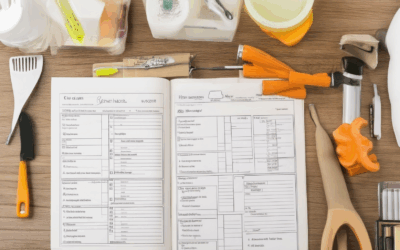Maintaining your home can seem daunting, especially if you’re new to the task. Whether you’re a first-time homeowner or just looking to take better care of your property, having a solid understanding of the basics is crucial. This comprehensive guide will walk you through everything you need to know about home maintenance, from the essentials to creating a schedule that works for you. With the right approach, you can keep your home in great shape year-round. From identifying common issues to learning how to tackle repairs yourself, this guide offers practical advice and actionable steps to help you get started. Don’t let home maintenance overwhelm you—use this checklist and tips to stay organized and ensure your home remains a safe and comfortable place for years to come.
Key Takeaways
– Mastering Home Maintenance: Begin with essential tools and tackle small projects to build confidence and skills.
– Budgeting for Maintenance: Set aside 1-4% of your home’s value annually for emergencies and large projects.
– Understanding Roles: Recognize a handyman or handyperson as the go-to for diverse tasks like repairs and installations.
– Efficiency with a Handyman: Hire a handyman for quick, versatile solutions to various home needs.

What is the 1 rule for home maintenance?
The 1 rule for home maintenance is to allocate 1% of your home’s purchase price annually for repairs and upkeep. This rule has evolved over time to account for modern construction costs and inflation, making it a practical guide for homeowners.
- The 1% Rule: Set aside 1% of your home’s value for maintenance. For a $300,000 home, this means $3,000 annually or approximately $250 per month. This covers unexpected repairs and routine checks.
- Regular Inspections: Schedule annual inspections for major systems like HVAC, plumbing, and electrical components. Early detection of issues can save money and prevent costly repairs.
- Professional Help: Consider hiring professionals for certain tasks, such as gutter cleaning or chimney inspections, to ensure safety and reliability.
- Check for Damage: Regularly inspect for signs of wear, leaks, or damage, especially in high-traffic areas like roofs, windows, and doors.
- Emergency Preparedness: Test smoke detectors and fire alarms annually to ensure they are functioning properly and update outdated units.
For more detailed guidance and professional services, visit Sams Maintenance . Their experts provide comprehensive home maintenance solutions tailored to your needs.
What Maintenance Needs to Be Done on a House?
The maintenance of a house involves several critical tasks that ensure the property remains in good condition and prevents costly repairs. Here’s a comprehensive guide to essential home maintenance tasks:
- Roof Maintenance
- Clean gutters and downspouts to prevent clogs and water damage.
- Inspect for missing or damaged shingles and repair as needed.
- Check flashing around chimneys and vents for proper sealing.
- Trim tree branches close to the roof to avoid damage from falling limbs.
- Plumbing Maintenance
- Check for leaks under sinks, toilets, and bathtubs.
- Regularly clean drain traps to prevent slow draining.
- Inspect pipe connections for wear and tear.
- Schedule annual professional plumbing inspections.
- Heating and Cooling Systems
- Change or clean HVAC filters monthly to maintain efficiency.
- Test programmable thermostats to ensure correct temperature settings.
- Inspect ductwork for leaks or blockages that affect airflow.
- Schedule regular HVAC tune-ups to catch potential issues early.
- Electrical System
- Check outlets and switches for tripping issues or flickering lights.
- Test circuit breakers to ensure they function properly.
- Inspect exposed wiring outside the house for damage or wear.
- Replace outdated electrical components to meet safety standards.
- Exterior Maintenance
- Paint exterior surfaces every 3-5 years to protect against weather damage.
- Inspect fences and decks for rot, warping, or loose boards.
- Check walkways and driveways for cracks and repair as needed.
- Trim bushes and trees to maintain proper spacing and visibility.
- Appliance Maintenance
- Clean refrigerator coils to improve energy efficiency.
- Check dishwasher door seals for proper closure and cleanliness.
- Clean garbage disposal by running hot water and using a disposal cleaner.
- Scheduled maintenance for major appliances like ranges and refrigerators.
- Landscaping and Yard Care
- Prune trees and shrubs to maintain shape and health.
- Check for invasive plants or pests that could harm the lawn.
- Mow and fertilize grass regularly to promote healthy growth.
- Inspect for dead trees or branches that may fall and damage the property.
- Fire Safety
- Test smoke detectors and carbon monoxide detectors monthly.
- Ensure fire extinguishers are fully charged and accessible.
- Inspect chimneys and flues for proper clearance and condition.
- Keep grills and fire pits at least 10 feet away from the house.
- Budgeting and Preventative Planning
- Create a maintenance budget to cover unexpected repairs.
- Establish a regular maintenance schedule for key systems.
- Know when to replace aging components like roofs or HVAC systems.
- Consult professionals for complex repairs or renovations.

Creating a Simple Home Maintenance Schedule
To keep your home in great shape, follow this organized and easy-to-follow maintenance schedule tailored for busy homeowners:
Monthly Home Maintenance Tasks
- Check HVAC System: Inspect filters and vents for cleanliness and blockages.
- Inspect Plumbing: Look for leaks near sinks, toilets, and pipes.
- Examine Roof: Check for missing shingles or damage.
- Paint and Stain Check: Monitor surfaces for peeling or wear.
- Prune Trees/Bushes: Trim overgrown plants to maintain health and safety.
- Deck Inspection: Check for weathering or structural issues.
- Foundation Check: Look for cracks or signs of shifting.
- Window and Door Check: Inspect seals and frames for damage.
- Appliance Maintenance: Clean oven, empty dryer lint, test smoke detectors, and check GFCI outlets.
- Electrical Systems: Test circuit breakers and update outdated wiring if necessary.
- Plumbing Inspection: Examine water heater and drain lines.
Seasonal Home Maintenance Tips
- Spring Cleaning: Prepare for the season by cleaning gutters and checking lawn equipment.
- Summer Preparation: Schedule AC tune-ups and plan for plant watering schedules.
- Fall Readiness: Inspect the furnace and prepare for cooler weather.
- Winter Safety: Protect pipes from freezing and remove snow from the roof to prevent ice dams.
Additional Tips for Success
- Adjust the schedule based on your specific home needs and local climate conditions.
- Stay organized by noting due dates on a calendar or planner.
- Consider hiring professionals for tasks you’re uncomfortable tackling yourself.
For detailed guides on each task, visit our Home Maintenance Guides section.

How to Learn House Maintenance
To effectively learn house maintenance, follow these organized steps:
- Start with Basic Tools: Invest in essential tools like a screwdriver set, wrenches, measuring tape, and a toolkit. These are fundamental for most maintenance tasks.
- Learn from Experience: Begin with simple tasks like changing light bulbs or fixing leaky pipes. These small projects build confidence and familiarity with your home’s systems.
- Understand House Systems: Study how different systems interact. For example, understand how plumbing, electrical, and HVAC work together to maintain your home’s functionality.
- Prioritize Preventative Maintenance: Regularly inspect areas like gutters, chimneys, and HVAC units. Address issues early to prevent costly repairs later.
- Stay Informed Through Resources: Utilize trusted online guides, forums, and videos. Websites like Sam’s Maintenance offer detailed guides and expert advice.
- Network with Experts: Join local homeowner associations or online communities to connect with experienced individuals who can share knowledge and tips.
- Take Courses or Workshops: Consider enrolling in DIY courses or attending workshops to gain deeper insights and practical skills.
- Volunteer or Intern: Offer to help friends, family, or neighbors with their home projects. This hands-on experience is invaluable for learning.
How Much Money Should You Set Aside for Home Maintenance?
To effectively manage home maintenance costs, it’s recommended to set aside between 1% to 4% of your home’s value annually. This range ensures you’re prepared for both routine upkeep and unexpected repairs.
1% for Emergencies:
- Covers unexpected repairs, such as a burst pipe or electrical issues.
- Ideal for quick fixes and small-scale maintenance tasks.
4% for Comprehensive Projects:
- Allocates enough funds for larger projects like roof repairs, appliance replacements, or kitchen remodels.
- Ensures you’re ready for significant upgrades or renovations.
Examples:
- A $300,000 home: 1% = $3,000; 4% = $12,000
- A $500,000 home: 1% = $5,000; 4% = $20,000
Organizing Your Fund:
- Divide the fund by room or system (e.g., plumbing, HVAC).
- Track expenses to ensure funds are used efficiently.
Annual Review:
- Adjust your allocation based on your home’s needs and personal preferences.
- Consider increasing the percentage if you live in an area with harsh weather conditions or have an older home requiring more frequent updates.
By setting aside this percentage, you can maintain your home’s health and enjoy peace of mind knowing you’re financially prepared for whatever comes your way.

What Do You Call Someone Who Does House Maintenance?
A person skilled in home maintenance tasks is commonly referred to as a handyman or handyperson . These professionals are versatile and can handle a wide range of chores, including minor repairs, installations, and improvements. Other terms often used include:
- Fixer : Often used when the individual is focusing on larger-scale renovations or repairs.
- Maintenance Worker : A broader term that may include more specialized roles beyond general handyman services.
Scope of Work
A handyman or handyperson typically has expertise in skills such as: – Basic carpentry – Plumbing – Minor electrical wiring – Property maintenance – Painting – Landscaping – Appliance installation
Why Choose a Handyman?
Hiring a handyman is ideal for homeowners looking to tackle projects efficiently without needing to hire multiple contractors. They offer flexibility and can often complete tasks faster due to their diverse skill set.
For professional assistance with home maintenance, visit Sams Maintenance to explore detailed guides and expert advice tailored for homeowners.
Conclusion
Whether you’re searching for someone to fix leaks, install new furniture, or perform routine maintenance, a handyman or handyperson is a reliable choice for keeping your home in great shape.




0 Comments